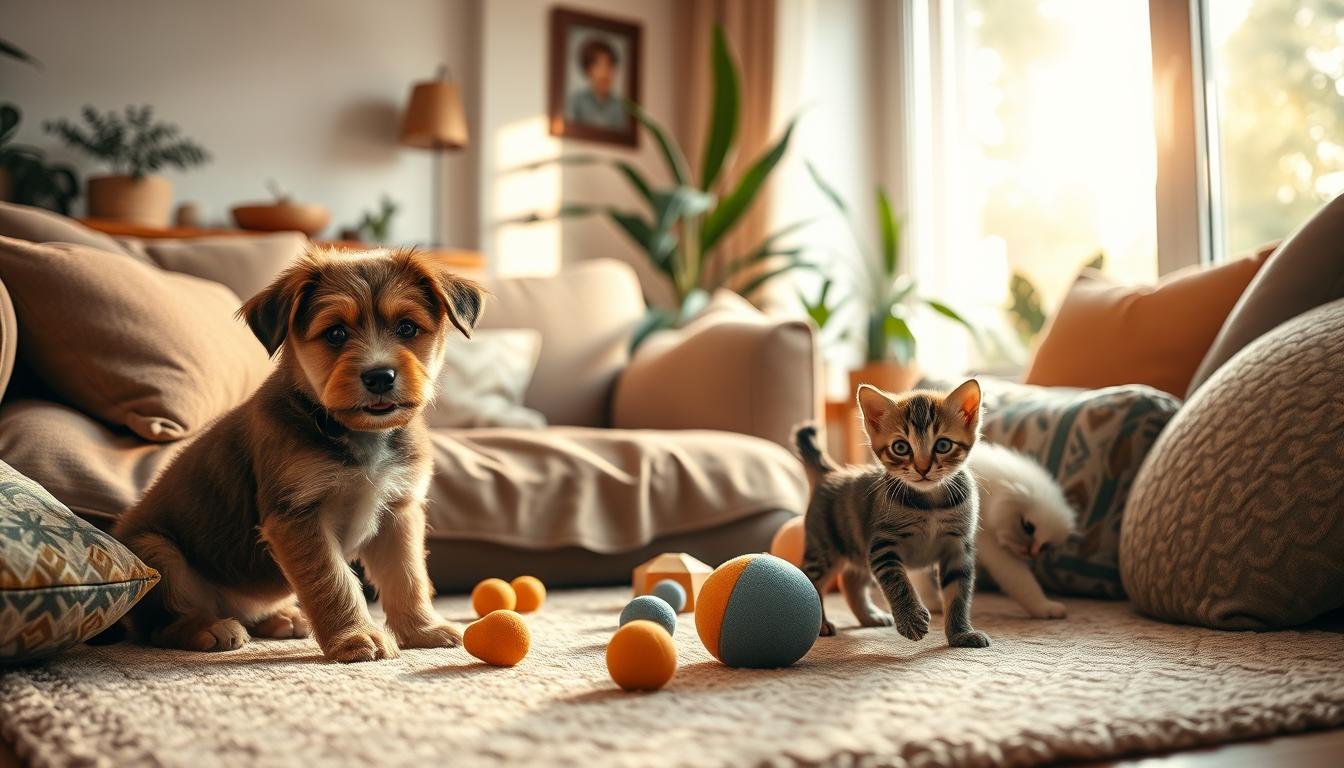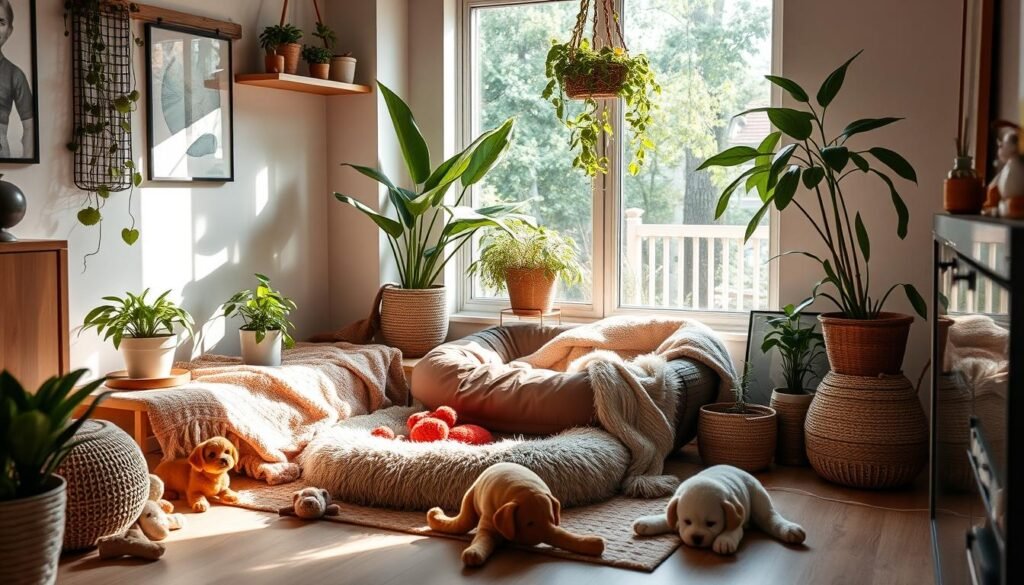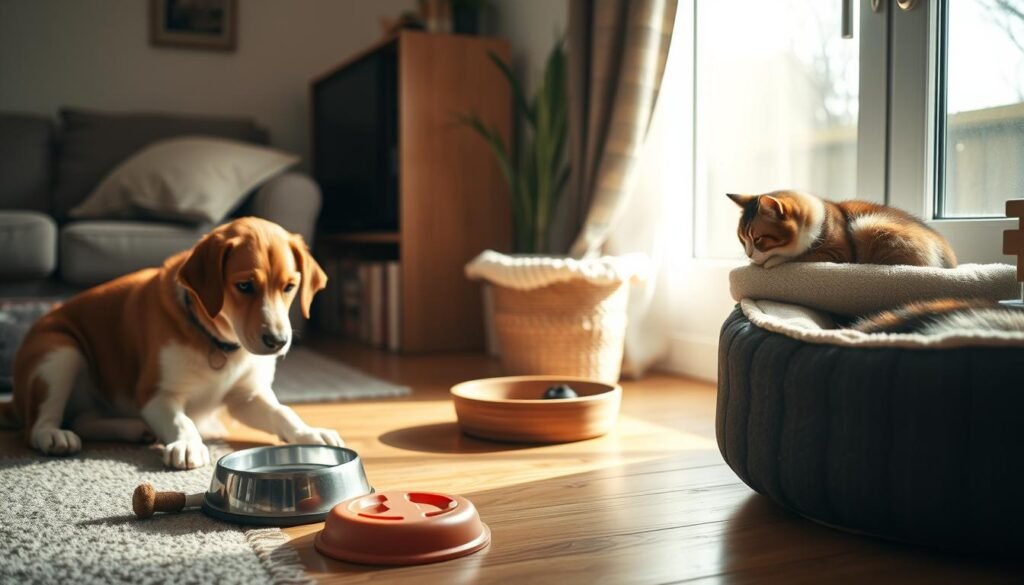
“The greatness of a nation can be judged by the way its animals are treated.” – Mahatma Gandhi
Bringing a new pet home is exciting and crucial. It’s more than just adding a pet; it’s welcoming a new family member. I learned quickly that a strong start is key for a happy life together. Preparation, patience, and the right mindset are vital for a smooth transition.
For new pet owners, it can feel overwhelming. But, a good guide can make it rewarding. Following the Humane Society of North Texas (HSNT) advice and the 3-3-3 rule can help a lot.
Whether it’s a cute kitten or a lively puppy, making your home welcoming is essential. This guide aims to make the journey smooth, filled with joy and bonding.
Key Takeaways
- Understanding the importance of the first initial days, weeks, and months in a pet’s new home.
- Adhering to the 3-3-3 rule for your new dog can facilitate better adaptation.
- The Humane Society of North Texas provides well-prepared pets, making the adoption journey easier.
- Organizing your space and having essential supplies ready for your pet’s arrival creates a welcoming home.
- Spending quality time and following expert guidelines can ensure a strong bond with your new family member.
Preparation is Key: Getting Ready for Your New Pet
Getting ready for a new pet means more than just bringing them home. It’s about making a safe and loving space for them. You need to set up a cozy area, get the right supplies, and prepare for a smooth transition.
Creating a Safe and Cozy Space
Before your pet arrives, make a safe area for them. This space should be free from dangers like electrical cords and small objects. It’s like baby-proofing, but for your new pet. Adding personalized toys and accessories can also make them feel at home.

Essential Supplies Every Pet Owner Needs
Getting the right supplies is key when preparing for a new pet. Here’s a list of the basics you’ll need:
- Bedding: Soft and washable beds or blankets.
- Bowls: Separate dishes for food and water.
- Toys: Durable toys that are safe for chewing and playing.
- Grooming Tools: Brushes, nail clippers, and shampoo.
- Diet: A balanced diet suited to your pet’s age and health.
- Leash and Collar: If you have a dog, properly fitting gear is essential for walks.
New Pet Checklist
Use this checklist to make sure you don’t forget anything:
| Item | Description |
|---|---|
| Health Check-up | Schedule a vet appointment within 48-72 hours of arrival. |
| Personalized Items | Include name tags and customized bedding for familiarity. |
| Behavioral Observations | Watch for any signs of stress or comfort to adjust their setting. |
| Transport | Ensure a smooth ride home with a secure carrier and calm environment. |
| Daily Routine | Establish and stick to a schedule for feeding, potty breaks, and playtime. |
| Safety | Pet-proof the home and yard, removing hazardous items from reach. |
By focusing on these essentials, you can create a nurturing environment. This ensures your new pet feels welcomed, secure, and cherished from day one.
The First Days: Making New Pets Feel at Home
Bringing a new pet home is exciting but can be tough for them. The first days are key to making them feel safe and loved. Here are some tips to help your pet feel at home.

Establishing a Daily Routine
Creating a daily routine is crucial for pets in their first days. It helps them adjust to their new home. Start with a regular feeding schedule, like three to four small meals a day for young dogs.
It’s also important to take them out often, especially after eating, drinking, sleeping, or playing. This helps with house-training.
Walking is another key part. For puppies, start with short walks and gradually make them longer. Giving them safe toys, like Nylabones, helps them release energy and deal with teething.
Decompression Period
Give your new pet some time to relax in the first few days. This helps them adjust without too much stress. Keep your home quiet and consistent, and provide a safe space like a crate.
Introduce your pet to the family on a weekend or when you’re home for a while. This helps build trust and lets you watch how they adjust.
Make sure to take your pet to the vet within a week to check their health. Also, make sure any other pets in the house are healthy and up-to-date on shots before bringing a new one home.
Young puppies sleep a lot, up to 18 to 20 hours a day. As they get older, they sleep less. Letting them rest is important for their happiness and health.
New Pets Home
Getting a new pet is exciting, but it needs careful planning. This is especially true when introducing pets to family and other animals. The right steps can make the transition smooth and keep your home peaceful.

Introducing Your Pet to Family Members and Other Animals
Start slow when introducing pets to family. Young puppies need a calm place because they get sick easily. Slow introductions help avoid stress and health issues.
Adult dogs might take longer to adjust, especially if they’ve been rehomed before.
Cats have their own rules too. Keep the new cat in a separate room for a week to help it adjust. Use separate towels and let them get used to each other’s smells. Start with small visual meetings to build positive feelings.
When introducing a dog to a cat, keep the dog on a leash. Use treats and praise to help them get along.
Managing Initial Hiccups and Misbehavior
It’s important to manage pet behavior when they first arrive. Dogs and cats need close supervision. Activities and routines can make them feel secure and adjust faster.
Young puppies like to explore with their mouths, so make sure your home is safe. Remove things that could harm them, like power cords and toxic plants. When changing their diet, do it slowly to avoid upset stomachs.
Most dogs and cats can live together peacefully. But, it’s important to watch their interactions to keep everyone safe and happy.
| Adjustment Time | Key Strategies |
|---|---|
| A few days to a few months | Cats should be kept separated for at least one week; dogs need gradual introductions and close monitoring. |
| Initial Behavioral Issues | Use enrichment and consistent routines; monitor interactions, and provide positive reinforcement. |
| Health Precautions | Puppies need a specific diet and secure environment; watch for symptoms of distress like vomiting and diarrhea. |
By following these tips, you can manage your pet’s behavior well. This will make your home a welcoming place for your new furry friend.
Nutrition Essentials for a Healthy Start
It’s crucial to give your pet a strong nutritional start for their health and happiness. Good nutrition affects their growth, energy, and ability to fight off sickness. Knowing about healthy pet nutrition and a regular feeding schedule is key for a long, happy life with your pet.
Feeding Schedule for Pets
Having a set feeding schedule is very important. It keeps your pet’s digestive system regular and their energy up all day. Here are some tips:
- Consistency: Feed your pet at the same times each day to help establish routine.
- Portion Control: Measure portions accurately to prevent overfeeding or underfeeding.
- Frequency: Puppies and kittens may require more frequent meals, while adult pets usually do well with two meals per day.
- Activity Level: Adjust the feeding schedule based on your pet’s activity level and weight management goals.
Healthy Pet Nutrition Tips
Good pet nutrition is about both quality and quantity. Choosing the right food and making sure it fits your pet’s needs is very important. Here are some tips:
| Pet Type | Diet Requirements |
|---|---|
| Dogs | Dogs are omnivores and need a balanced diet of proteins, fats, and carbohydrates.
|
| Cats | Cats are obligate carnivores, requiring high levels of protein and specific nutrients such as taurine and arachidonic acid.
|
When picking pet food, look for products that meet AAFCO standards. This ensures your pet gets the nutrients they need for health.
Every pet is different. Talk to your vet to make a feeding plan that fits your pet’s needs. A good nutrition plan and a regular feeding schedule will help your pet stay healthy and full of energy.
Training Basics to Help Your Pet Adapt
Training new pets is key for a happy home. Knowing and using important training methods greatly affects pet behavior and how they adjust. I’ll cover the basics of training, like positive reinforcement, setting rules, and the benefits of pet training classes.
Positive Reinforcement Techniques
Positive reinforcement is a great way to train pets. It means rewarding them for good behavior to encourage it more. This method creates a positive learning space and strengthens the bond between pet and owner. Treats, praise, and petting are common rewards that work well when used often.
Unlike punishment, positive reinforcement lowers pets’ anxiety and fear. It makes them more likely to follow commands and learn. Giving rewards right after the good behavior helps pets understand the link between action and reward.
Setting Boundaries and Rules
Setting clear rules is vital when training pets. Pets like knowing what’s expected of them. Having rules like where pets can go in the house helps create a structured space. This clarity reduces confusion and misbehavior.
Using the same commands and gestures is helpful. For example, teaching a dog to stay out of the kitchen while cooking works well. Start with a command like “out” and guide them away, then reward them for staying out.
It’s important for all family members to agree on rules. Talking about how to manage behavior before starting ensures everyone is on the same page. This way, the pet gets a clear message from everyone.
Enrolling in Training Classes
While home training is good, pet training classes offer extra benefits. These classes are run by experts and cover many behaviors and situations. They provide a place for pets to learn and interact with others in a controlled way.
Training classes are great for learning new techniques and solving specific behavior problems. They also offer a chance to meet other pet owners and get support. This shared experience helps with learning and gives owners peace of mind.
These classes focus on positive reinforcement and teach how to use it effectively. This helps pets learn faster and more efficiently.
| Type of Training | Benefits |
|---|---|
| Home Training | Cost-effective, personalized approach, establishes a direct bond |
| Pet Training Classes | Access to professional guidance, socialization opportunities, structured learning |
Pet-Proofing Your Home: Safety Tips
Ensuring pet safety at home is more than just the initial excitement. It’s about making your home safe for your new pet. Here, we’ll cover how to pet-proof your home room by room. This will help create a safe space for your furry friends.
Identifying and Removing Hazards
| Room | Safety Recommendations |
|---|---|
| Living Room |
|
| Kitchen |
|
| Bathroom |
|
| Bedroom |
|
| Garage |
|
| Yard |
|
Creating a Safe Space for Your Pet
Creating a safe area for your pet is key for pet safety at home. This area should be free from hazards. For example, use anti-chew sprays on furniture for puppies. For older dogs, ramps can help with joint pain.
Kittens need regular litter box cleaning and lots of toys. Pet-proofing is an ongoing task. Regularly check each room from your pet’s view to find hidden dangers. Stay vigilant and adjust as needed to keep your pets safe and happy.
Building Trust and Bonding with Your New Pet
Creating a strong bond with your new pet is key for a happy relationship. This bond boosts your pet’s happiness and cuts down on bad behavior. It also makes training easier. Here are tips on how to spend quality time, keep your pet’s mind active, and understand their behavior to build a strong connection.
Spending Quality Time Together
Quality time is the foundation of trust with pets. Regular routines for meals, walks, and playtime make your pet feel safe and know what to expect. Playing games like fetch and hide-and-seek strengthens your bond. Using treats and praise during training helps too.
Grooming like brushing and bathing is also a great way to show care and affection. It’s a chance to bond while doing something important for your pet’s health.
Pet Entertainment Ideas and Mental Stimulation
Mental stimulation is as important as physical activity for pets. Taking them on walks, hikes, or to parks is good for both their mind and body. Toys and puzzle feeders keep their minds sharp. Changing toys regularly keeps things interesting.
Talking to your pet and using gestures helps them understand you better. This is key for building trust and a strong connection.
Understanding Your Pet’s Cues and Behavior
Getting to know your pet’s cues is essential for a strong bond. Paying attention to their behavior and responding quickly builds trust. Giving them a quiet, cozy spot to relax helps them feel safe.
Letting your pet come to you when they’re ready is important, especially for shy pets. Building trust takes time, sometimes weeks or months. Be patient and consistent.
| Activity | Benefits |
|---|---|
| Consistent Routines | Reduces stress and enhances security |
| Positive Reinforcement | Build trust and improve training response |
| Grooming | Opportunities for care and affection |
| Interactive Play | Enhances bonding and mental stimulation |
| Active Listening | Builds trust through prompt response |
Conclusion
Welcoming a pet into your home can change your life for the better. With 68% of U.S. homes already having pets, it’s a big step. It’s a promise to care for a friend who will bring joy and comfort.
This guide has shown that preparation, consistency, and patience are key. Studies have shown pets can make us happier and healthier. They can even help kids with autism and ADHD.
Caring for pets teaches kids about responsibility and kindness. It also helps adults feel less stressed and anxious. Pets can make us feel better and even help us live longer.
Starting this journey can be incredibly rewarding. By understanding the needs of pets, new owners can enjoy the many benefits they bring. The love pets give us is endless, making every day special.
Everything you can find for your favorite pet can be found here on Amazon
FAQ
What are the first steps to prepare my home for a new pet?
What should I include in my new pet checklist?
How can I help my new pet feel at home during the first few days?
What’s the best way to introduce my new pet to family members and other pets?
How can I manage initial behavioral issues with my new pet?
What is the ideal feeding schedule for new pets?
How can I ensure my pet’s nutrition is balanced?
What are some effective training techniques for new pets?
How can I pet-proof my home to ensure safety?
What activities can help me bond with my new pet?
Source Links
- https://www.hsnt.org/post/the-3-3-3-rule
- https://www.dogsoutloud.org/2013/05/so-youve-brought-home-a-new-dog-now-what/
- https://www.animalcareexperts.com/blog/preparing-to-bring-home-a-new-pet-a-guide.html
- https://hscarroll.org/preparing-for-the-arrival-of-a-new-pet/
- https://www.humanesociety.org/resources/how-make-your-new-dog-feel-comfortable-your-home
The Baffls Team (info@baffls.com)
Explore Your World with BAFFLS: Your Ultimate Day Companion!
Disclosure: This post contains affiliate links. If you make a purchase through these links, I may earn a commission at no additional cost to you. We only recommend products or services that I personally use and believe will add value to my audience. Your support helps keep this content free for everyone. Thank you for your support!
Prices and discounts noted at the time of publication Saturday January 18, 2025. They may have been changed without notice by the retailer at the time you view this page.








